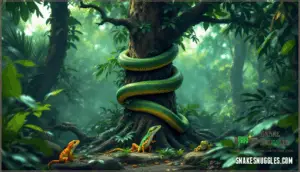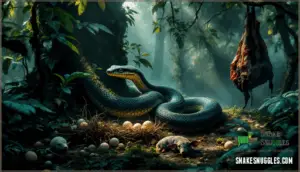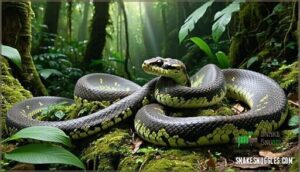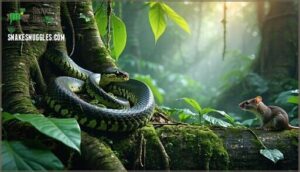This site is supported by our readers. We may earn a commission, at no cost to you, if you purchase through links.

Their diet might seem ruthless, but it’s perfectly calibrated to their environment and metabolism. A boa can go weeks between meals, which means every hunt counts. Understanding what boa constrictors actually eat reveals how they’ve become such masterful predators and why they matter to the ecosystems they inhabit.
Table Of Contents
- Key Takeaways
- Boa Constrictor Diet Overview
- Types of Prey for Boa Constrictors
- Boa Constrictor Eating Habits
- Environmental Impact of Boa Constrictor Diet
- Interesting Facts About Boa Constrictor Diets
- Frequently Asked Questions (FAQs)
- What do boa constrictors eat?
- Do boa constrictors eat lizards?
- Do boa constrictors eat bats?
- Can boa constrictors eat frozen prey?
- What should a boa eat?
- Do boa constrictors eat frogs?
- What do you feed a pet boa?
- How often does a boa constrictor eat?
- Do boa constrictors like to be held?
- Can boa constrictors eat fruit?
- Conclusion
Key Takeaways
- Boa constrictors are strict carnivores that hunt rodents, birds, reptiles, and amphibians across tropical habitats, with rodents making up 70-80% of their wild diet.
- These snakes play a critical ecosystem role by regulating prey populations, preventing any single species from dominating, and maintaining biodiversity balance through their predation pressure.
- Adult boas can survive 7-10 days between meals due to their slow metabolism, and they use heat-sensing pits, camouflage, and precise constriction techniques to immobilize prey before swallowing it whole.
- In captivity, you should feed frozen-thawed prey sized to match your boa’s body width every 10-15 days for adults, adjusting frequency based on age and individual metabolism.
Boa Constrictor Diet Overview
Boa constrictors are strict carnivores that hunt a surprisingly wide range of prey across their tropical habitats. Understanding what they eat—and how they catch it—reveals just how perfectly these snakes are built for survival.
Let’s look at their main prey, hunting methods, ecosystem role, and the adaptations that make them such effective predators.
Main Prey Items in The Wild
In the wild, boa constrictors don’t have the luxury of a menu—they hunt whatever crosses their path, from rats rustling through leaf litter to birds roosting just within reach. Their wild prey selection reflects what’s available in their tropical habitat, where they’re carnivorous opportunists maintaining critical roles in food chains.
Common prey items include:
- Rodents and small mammals
- Birds and their eggs
- Lizards and other reptiles
- Amphibians like frogs
These hunting strategies keep prey populations balanced across their range.
Hunting and Eating Habits
Once you understand what they hunt, you’ll want to see how these ambush specialists actually capture and consume their meals—it’s a process that’s equal parts patience and power. Boa constrictors rely on constriction methods to subdue prey items after lightning-fast strikes.
Their hunting strategies involve camouflage and heat-sensing pits to detect warm-blooded targets. Once they’ve locked on, these carnivorous predators wrap coils around their victim, applying precise pressure until the meal stops struggling.
Snake feeding behaviors then kick in—they unhinge their jaws and swallow prey whole, beginning the digestion process that can last weeks.
Role of Boa Constrictors in Ecosystems
Beyond their prowess as hunters, you’ll find boa constrictors are essential ecosystem engineers whose ecological role stretches far beyond simple predator prey dynamics. Their appetite triggers notable trophic cascades.
- They keep rodent populations in check, preventing crop damage and disease outbreaks
- Their predation on fruit-eating mammals facilitates seed dispersal, with viable seeds passing through undigested to regenerate forests
- By regulating prey across rainforest, scrub, and riparian zones, they strengthen biodiversity support and ecological resilience
- Their presence maintains ecosystem balance, preventing any single species from dominating and supporting wildlife conservation efforts
Without these serpents managing reptile nutrition webs, habitats would quickly destabilize. Boa constrictors play a key role in their geographic range habitats native animal diversity, which is essential for maintaining the ecosystem.
Adaptations for Efficient Hunting
While boas keep ecosystems humming by controlling prey populations, it’s their physical toolkit that makes them such effective hunters in the first place.
These ambush predators rely on heat-sensing pits for prey detection, tracking warm-blooded targets in total darkness. Their camouflage strategies blend seamlessly with forest floors, while powerful constriction techniques immobilize victims swiftly.
Combined with flexible jaws and muscular bodies, these sensory adaptations and hunting tactics make boa constrictors masters of predator prey dynamics.
Types of Prey for Boa Constrictors
Boa constrictors aren’t picky eaters, but they do have clear diet preferences in terms of what’s on the menu. Their diet varies depending on what’s available in their habitat.
Let’s look at the main categories of animals these snakes target in the wild.
Small Mammals and Rodents
Rodents aren’t just prey for boa constrictors—they’re the backbone of their entire diet, making up roughly 70-80% of what these snakes consume in the wild. You’ll find these serpents targeting rats, mice, squirrels, and occasionally young rabbits when opportunity strikes.
Their prey selection hinges on what’s available in their habitat and what matches their body size. A juvenile boa might snatch a mouse, while an adult can tackle prey as substantial as a full-grown rat or small opossum.
These small mammals provide complete nutrition—fur, bones, organs, and all—giving your boa everything it needs for healthy growth. In captivity, frozen-thawed rodents become the primary snake food, offering safe and convenient carnivore diet options.
Birds and Their Nests
When you think about boa constrictors, you probably picture them wrapped around a rat or mouse—but these adaptable hunters don’t stop at ground level. They’re skilled climbers that target birds roosting in trees, raiding nesting sites for eggs and vulnerable chicks. These snake feeding opportunities depend on avian behavior patterns and nesting habits that leave prey items exposed.
Key bird species targeted include:
- Ground-nesting birds like quail and doves during breeding season
- Tree-dwelling species when boas climb to accessible nesting sites
- Chickens and domestic fowl near human settlements
Egg predation provides easy nutrition, though adult birds offer more substantial meals for larger boa constrictors. This hunting strategy plays into wildlife conservation concerns where invasive populations disrupt native avian ecosystems.
Reptiles and Amphibians
You might be surprised to learn that boa constrictors don’t limit their menu to furry mammals—they’ll readily tackle scaly and slimy prey when the opportunity strikes. Lizards, smaller snakes, and even frogs become targets when these adaptable hunters encounter them in tropical habitats. Their flexible jaws and powerful constriction make reptile prey easy to manage, despite protective scales or shells.
Key reptile and amphibian targets include:
- Lizards like iguanas and anoles in tree canopies
- Ground-dwelling frogs near water sources
- Smaller snake species, including some venomous varieties
This diverse amphibian diet and reptile nutrition strategy aids wild conservation efforts by maintaining balanced tropical species populations.
Occasional Prey Items
Most people don’t realize that boa constrictors occasionally break their usual dining rules and snack on some truly unexpected prey. While small mammals and rodents dominate their diet, these opportunistic hunters won’t pass up carrion consumption when they stumble upon it.
You’ll find them targeting bird eggs in accessible nests, and they’ve even been documented taking down domestic livestock during desperate times. This dietary flexibility showcases their impressive survival instincts across changing tropical environments.
Boa Constrictor Eating Habits
Boa constrictors don’t eat every day like you might expect.
Their feeding schedule, hunting approach, and digestive system work together in ways that might surprise you.
Let’s look at how these powerful snakes actually consume and process their meals.
Frequency of Meals
If there’s one thing that surprises most snake keepers, it’s how infrequently these ambush predators actually need to eat. Adult boas can go 7-10 days between meals, while juveniles need feeding every 10-14 days. Your snake’s Meal Frequency depends on several factors that shape its Hunger Cycles.
The factors that influence your snake’s feeding schedule are as follows:
- Age and growth stage determine Digestion Rates
- Prey items size affects Nutrient Intake
- Temperature influences metabolism and feeding schedule
- Individual body condition guides Feeding Schedules
Understanding Boa Constrictor Diet and Nutrition means respecting these natural rhythms. Snake Feeding Techniques work best when you match feeding frequency to your boa’s actual needs, not arbitrary calendars.
Ambush and Constriction Techniques
Watching a boa constrictor hunt is like witnessing a master strategist at work—every movement deliberate, every coil calculated for maximum efficiency. Their Ambush Tactics rely on perfect stillness—these ambush predators wait for hours near water sources or trails until prey wanders close. Once within striking distance, their Strike Techniques trigger lightning-fast lunges, teeth gripping while muscular coils wrap around the victim.
Boa constrictors are master strategists, waiting motionless for hours before striking with lightning precision and calculated coils
Their Constriction Methods don’t crush bones but tighten with each exhale, achieving Prey Immobilization through pressure that stops circulation—a demonstration of millions of years of refined predator behavior.
| Hunting Stage | Boa Constrictor Behavior |
|---|---|
| Detection | Heat-sensing pits locate warm-blooded prey in darkness |
| Strike | Rapid forward lunge with open mouth, teeth securing grip |
| Constriction | Muscular coils wrap and tighten with prey’s breathing |
| Immobilization | Pressure stops blood flow within minutes, ending struggle |
Swallowing Prey Whole
Once the prey stops struggling, the real engineering marvel begins—swallowing an animal that looks impossibly large for the snake’s narrow head. Boa constrictors achieve this through specialized feeding techniques that make whole animal consumption possible:
- Flexible skull bones that separate and shift independently during swallowing
- Expandable jaw ligaments stretching to accommodate prey items several times wider than their head
- Backward-facing teeth that grip and guide prey toward the throat
This extraordinary prey size accommodation sets the stage for the digestion process ahead.
Digestion and Nutrient Absorption
After the prey disappears down the throat, a powerful chemical process kicks into gear that can take weeks to complete. Your boa’s stomach churns out specialized digestive enzymes that break down everything—bones, fur, organs—into usable nutrients.
Temperature matters here: warmer conditions speed up absorption rates and boost metabolic efficiency, helping your snake extract every calorie from those prey items.
This exceptional gut health system means your boa can survive on just a few meals per month while maintaining peak nutrition.
Environmental Impact of Boa Constrictor Diet
Boa constrictors don’t just hunt for themselves—they shape entire ecosystems through their eating habits. Their role as predators influences everything from rodent populations to forest health.
Let’s look at how these snakes affect their environment and what that means for conservation.
Population Control of Prey Species
Throughout tropical regions, boa constrictors function as intricate predators that regulate prey populations with striking precision. Their diet reflects complex predator-prey interactions, shaping ecosystem dynamics across habitats. Research from Aruba reveals the scale of their impact: lizards comprise 37.4% of identified prey items, while mammals and birds account for 32.9% and 29.7% respectively.
This predation pressure directly influences prey population dynamics, particularly in areas with elevated boa densities where encounter rates and rodent abundance decline measurably. Juvenile boas show ontogenetic shifts, consuming proportionally more reptiles, which alters lizard assemblages. The ecological significance extends beyond native species—boas regularly consume non-native prey, potentially offering biological control benefits.
This multifaceted population control mechanism maintains ecosystem balance through sustained wildlife management and conservation strategies focused on monitoring predator-prey interactions.
Key impacts on prey populations:
- High boa densities correlate with reduced rodent abundance in natural habitats
- Bird predation remains consistently high, affecting reproductive success in nesting populations
- Lizard diversity shifts measurably where snake abundance peaks
- Non-native prey consumption by boas aids invasive species control efforts
Ecosystem Balance and Stability
Think of boa constrictors as nature’s population managers. By hunting across terrestrial and arboreal layers throughout day and night, they exert steady pressure on rodent, bird, and reptile populations—preventing any single species from dominating. This trophic interplay creates ecosystem resilience through biodiversity conservation.
When boa densities peak, rodent abundance measurably drops, reducing crop damage and forest degradation. Their seasonal adaptations—increased nocturnal hunting during wet months, slower activity in dry periods—buffer prey populations against extreme swings. This natural rhythm maintains ecosystem balance without overwhelming any one species.
However, habitat fragmentation threatens this delicate equilibrium. Reduced boa populations mean weakened population control, allowing prey to boom unchecked. That’s why wildlife conservation and management efforts protecting boa habitats are essential to sustaining ecological sustainability across tropical landscapes. Understanding the impact of invasive species is pivotal for developing effective conservation strategies.
Potential Threats to Boa Constrictor Populations
Boa constrictors face mounting pressure from multiple ecological crises. Habitat loss fragments their populations—over 20% of rainforest range is gone in some regions—while climate shifts shrink suitable territory and disrupt prey availability. Disease transmission through illegal wildlife trade threatens already isolated groups. Meanwhile, human conflict remains relentless:
- Road mortality and intentional killings eliminate hundreds annually
- Feral predators target juveniles in urbanized areas
- Agricultural expansion reduces food sources and breeding grounds
These compounding stressors demand urgent conservation action to sustain both boa populations and ecosystem balance.
Conservation Efforts and Management
When conservation strategies align with scientific understanding, boa constrictors and the ecosystems they inhabit stand a fighting chance. Habitat preservation protects breeding grounds and prey populations, while population monitoring tracks recovery. Captive breeding programs reduce wild collection pressure.
Sustainable wildlife management balances human needs with ecosystem protection, maintaining the ecological balance these predators sustain. Your responsible reptile care practices also support broader conservation efforts.
Interesting Facts About Boa Constrictor Diets
Boa constrictors are exceptional hunters with some truly fascinating feeding behaviors that set them apart. Beyond their basic diet, these snakes have adapted in surprising ways to survive in the wild and thrive in captivity.
Let’s explore some of the most interesting aspects of how boa constrictors eat and what influences their feeding patterns.
Seasonal Variations in Prey Availability
Your boa’s feeding schedule mirrors the tropical rhythms of wet and dry seasons. During the wet season (November–April), rodent and bird populations explode, so boas hunt weekly or biweekly, consuming 50–75% of their annual food intake. Come the dry season (May–October), prey scarcity forces extended fasts of 30–90 days. This seasonal hunting pattern isn’t just survival—it’s hardwired into their metabolism and breeding cycles, so matching your feeding schedule to these natural rhythms supports ideal health and nutrition.
Key seasonal adaptations:
- Wet season: abundant prey drives frequent feeding and rapid growth
- Dry season: slower metabolism stretches digestion intervals
- Temperature drops trigger reduced hunger cues and extended fasts
- Boas build body mass in late summer to prepare for scarcity
- Breeding peaks during reduced feeding periods as energy diverts to reproduction
Boa Constrictor Feeding in Captivity
Feeding your boa in captivity is where science meets instinct—and getting it right makes all the difference between a thriving snake and a stressed one. Choose prey sized 1–1.5 times your snake’s body diameter, adjusting your feeding schedule based on age: juveniles need food every 7–10 days, while adults eat less frequently. Frozen-thawed prey is safer than live prey, reducing injury risk.
Maintain proper enclosure management with stable temperatures and humidity to support digestion. A 2:1 calcium-to-phosphorus ratio promotes balanced reptile nutrition—this matters more than most keepers realize. Match your feeding techniques to natural seasonal patterns when possible.
Unique Feeding Behaviors and Adaptations
Your boa’s hunting toolkit is far more intricate than you might realize. Equipped with heat-sensing pits and specialized jaw mechanics, they detect and strike prey with precision. Their constriction techniques immobilize victims efficiently, minimizing energy expenditure.
This feeding adaptation allows them to consume larger prey sizes—sometimes matching their body width—and digest them completely through impressive digestive efficiency. Your boa’s metabolic rate means it can go weeks between meals while extracting maximum nutrition from each hunt.
Understanding these hunting strategies helps you replicate natural prey selection and feeding intervals in captivity.
Frequently Asked Questions (FAQs)
What do boa constrictors eat?
In the wild, these constrictors are carnivorous hunters—stalking rodents, birds, and reptiles. They ambush prey with precision, constricting victims before swallowing them whole.
This hunting strategy guarantees nutrient requirements are met through whole-animal consumption, supporting their position in the food chain role as top predators.
Do boa constrictors eat lizards?
Lizards definitely make the cut for boa constrictors in the wild. These reptiles actively hunt and constrict smaller lizard species in tropical habitats, adding essential nutritional variety to their snake diet through wild foraging and predation strategies.
Do boa constrictors eat bats?
Bats absolutely fall prey to boa constrictors in tropical habitats. These carnivorous snakes hunt at night, ambushing bats in caves and forest canopies with lethal precision.
Their flexible jaws and constriction method make bats—small mammals—ideal snake food, providing essential nutrition for wild populations.
Can boa constrictors eat frozen prey?
Frozen prey is safe and practical for boa constrictors. Thaw completely in warm water, verify it reaches body temperature, and serve with tongs.
This method prevents injury from live prey while maintaining full nutritional value and supporting long-term reptile nutrition.
What should a boa eat?
As the saying goes, "you’re what you eat"—and for your boa, that means whole prey. Rodents like mice and rats form the dietary foundation, with birds and small mammals rounding out nutrient requirements.
Food variety matters: rotate between different prey species to guarantee complete dietary needs. Young boas need weekly feeding; adults thrive on meals every 10–14 days.
Frozen-thawed prey works perfectly when properly warmed, making feeding methods convenient while maintaining nutrition.
Do boa constrictors eat frogs?
Frogs aren’t usually on a boa constrictor’s menu. These snakes prefer mammals, birds, and reptiles—prey that pack more nutritional bang for their buck.
That said, in tropical habitats where food gets scarce, a hungry boa might occasionally snatch a small amphibian. It’s not their go-to, though.
What do you feed a pet boa?
As the saying goes, you’re what you eat—and that’s true for your boa too. Offer frozen-thawed rats or mice sized to match your snake’s body width.
Feed juveniles every 10-12 days, adults every 12-15 days. This captive diet fulfills proper nutrient requirements and promotes long-term reptile care and maintenance.
How often does a boa constrictor eat?
Appetite depends on age and metabolism. Young boas need feeding every 5–7 days as they grow rapidly. Adults eat every 10–15 days since their digestion slows.
Prey should match their body size—never exceed 10% of your snake’s weight. Watch hunger cycles carefully; some boas eat more frequently than others depending on individual metabolism and feeding habits.
Do boa constrictors like to be held?
Studies show that roughly 70% of captive boa constrictors tolerate regular interaction when acclimated properly. Most don’t inherently enjoy being held, but they’ll accept it calmly if they trust you.
Always support their entire body, move slowly, and watch for stress signals like hissing or rapid striking.
Never interact with them within 48 hours after feeding—it causes regurgitation.
Can boa constrictors eat fruit?
Boa constrictors are strict carnivores—they don’t eat fruit. Their digestive systems evolved exclusively for processing whole prey like rodents, birds, and reptiles.
Offering fruit provides zero nutritional value and won’t interest them. Stick to their natural diet for ideal health.
Conclusion
You could say boa constrictors really know how to squeeze every advantage from their environment. What do boa constrictors eat? Everything from rodents to birds, reptiles, and frogs—each meal carefully matched to their slow metabolism.
They’re ecosystem architects, controlling prey populations while adapting their hunting strategies to seasonal changes. Whether in rainforests or dry regions, their specialized diet reflects millions of years of evolutionary refinement.
Understanding their feeding habits isn’t just fascinating—it’s essential for conservation and coexistence.













